The Rapid and Participatory Assessment of Land Suitability in Development Cooperation
Abstract
1. Introduction
2. Materials and Methods
2.1. Case Study
2.2. Study Area
2.3. Research Workflow, Data Sources and Methods
2.3.1. Identifying Relevant Land Uses
2.3.2. Mapping Land Capability Factors
- Low: under 1600 m AMSL.
- Medium: between 1601 and 2100 m AMSL.
- High: above 2100 m AMSL.
- low: slope inferior to 6%,
- medium: slope between 6 and 25%,
- high: slope over 25%.
- low, characterized by yellow or shallow brown soils of variable texture (mainly sandy-loamy or sandy-clayey) with weak A1 horizon in hilly or uneven topography.
- medium, characterized by light and brown soils, mainly sandy-clayey or clayey, with pronounced A1 horizon in uneven topography.
- high, characterized by light and brown clayey or clayey-sandy soils, with pronounced chernozemic A1 horizon in a flat or nearly flat topography.
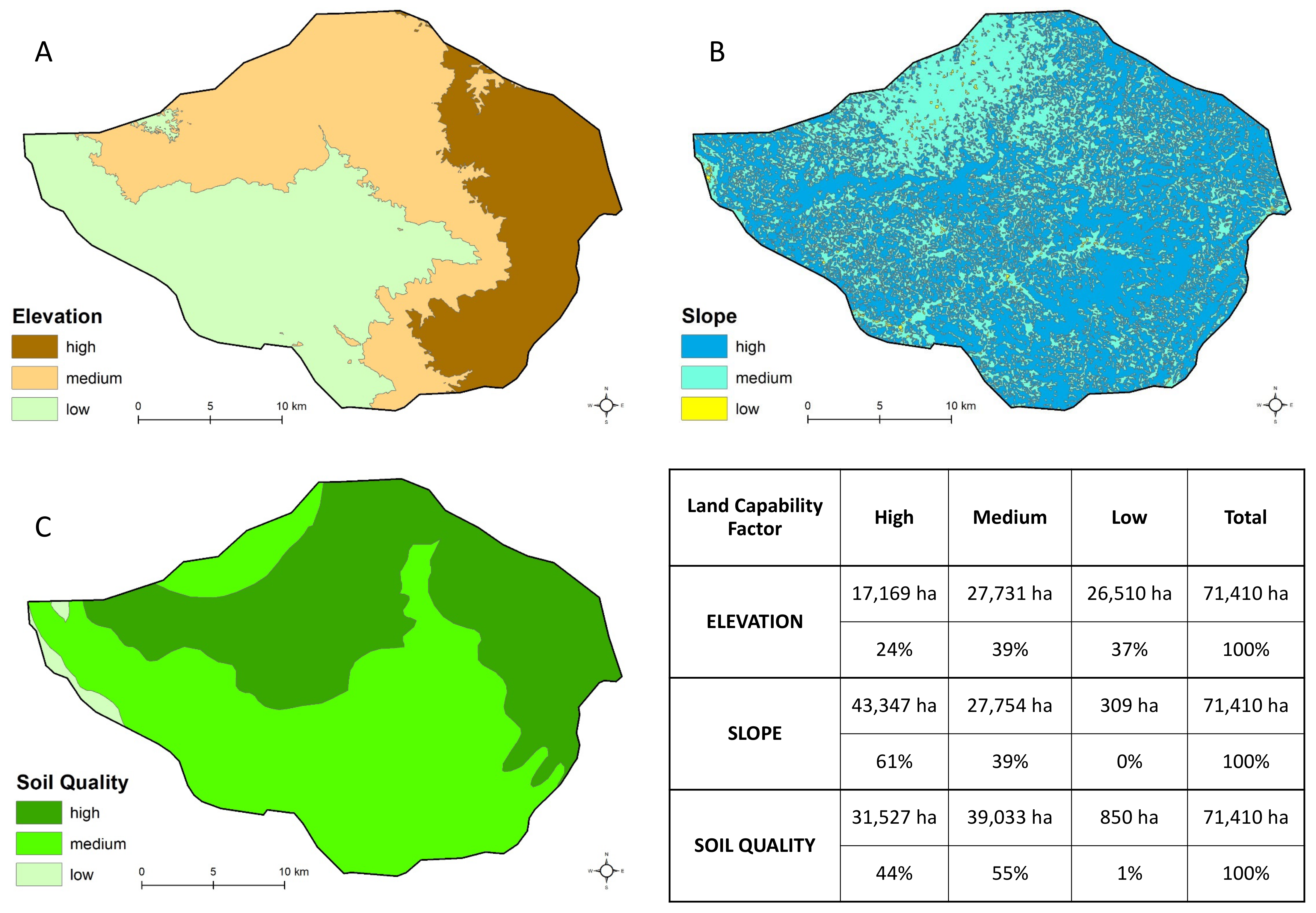
2.3.3. Defining the Suitability Scores for Each LUT
2.3.4. Mapping Potential Land Suitability for the Seven LUTs Considered
- -
- x (1–7) is one of the seven LUTs,
- -
- y (1–3) is one of the LCF (SQ, SL, EL),
- -
- z (1–3) is one of the LCF class (High, Medium, Low).
- -
- TSCxzi is the total suitability score of the i-th area, for the x-th LUT, for the z-th LCF class,
- -
- SCxz (SQ) is the suitability score, for the x-th LUT, of the the z-th class of soil quality,
- -
- SCxz (SL) is the suitability score, for the x-th LUT, of the the z-th class of slope,
- -
- SCxz (EL) is the suitability score, for the x-th LUT, of the the z-th class of elevation.
- -
- High, greater than 3,
- -
- Medium, greater than 2 and up to 3,
- -
- Low, up to 2.
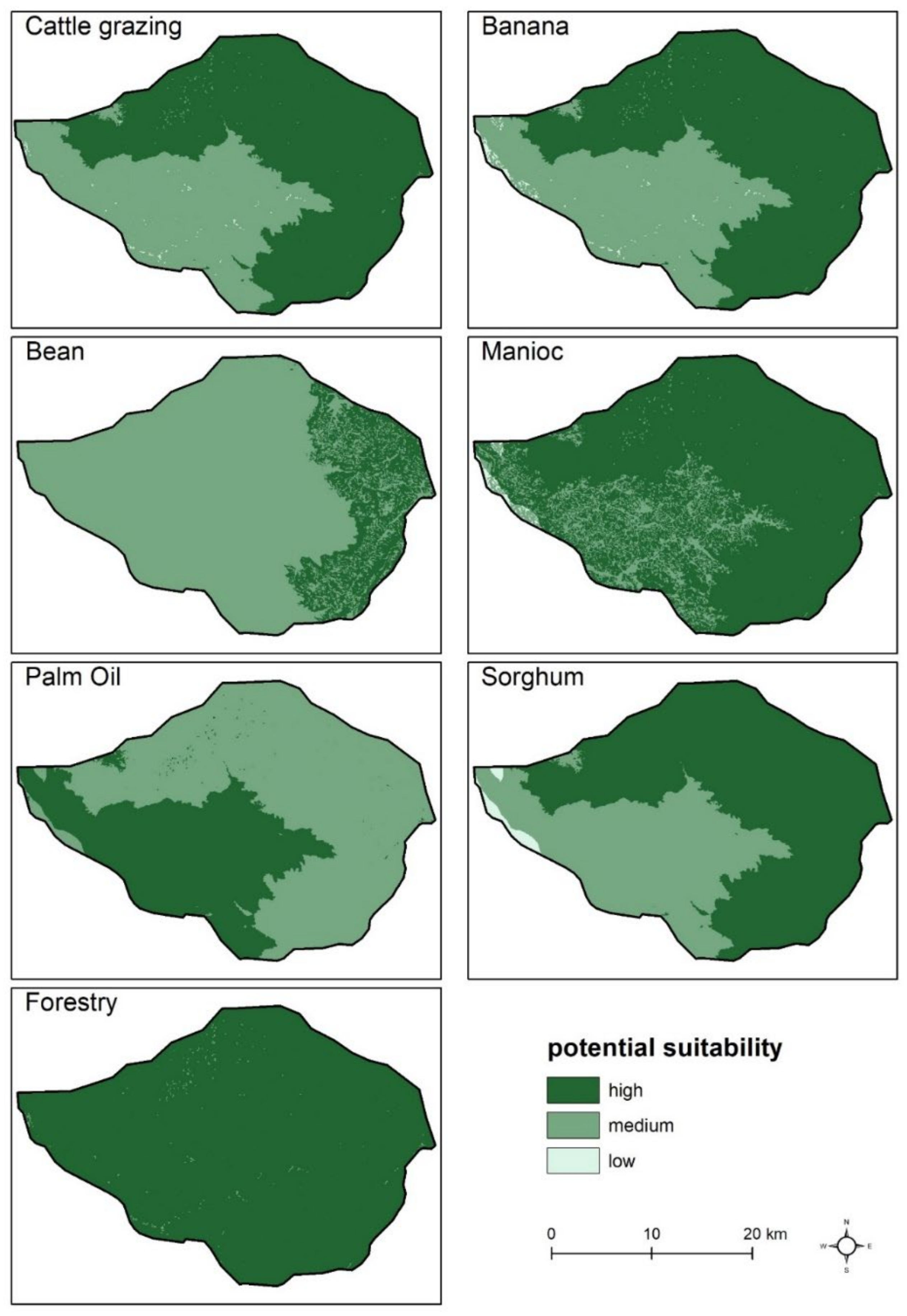
2.3.5. Mapping Accessibility
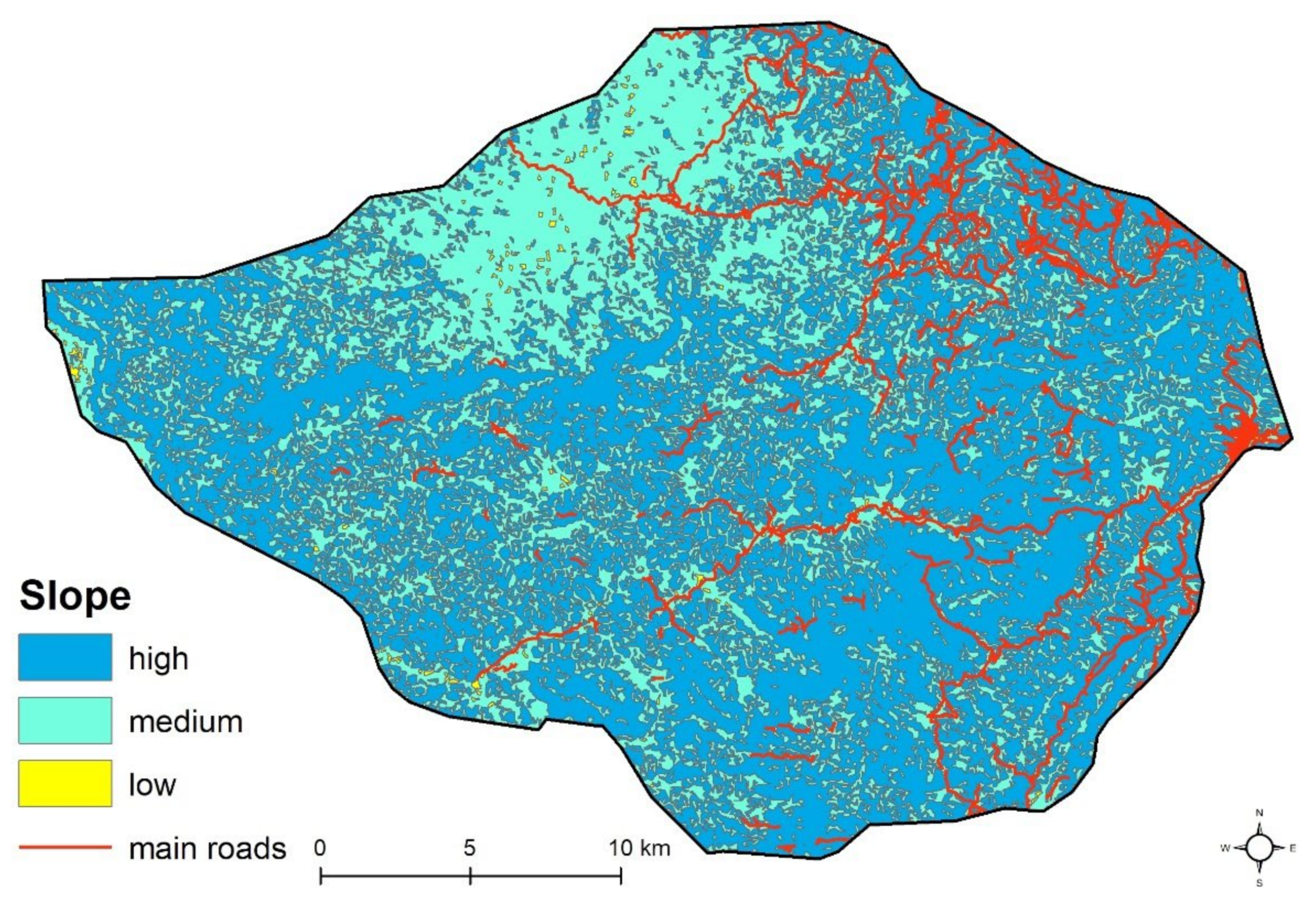
- High, with a CDi less than 200 m, that is 30 min walking,
- Medium-high: with a CDi of 200–400 m, that is 1 h walking,
- Medium: with a CDi of 400–600 m, that is 1.5 h walking,
- Low: with a CDi of 600–800 m, that is 2 h walking,
- null: with a CDi greater than 800 m, that is more than 2 h walking.
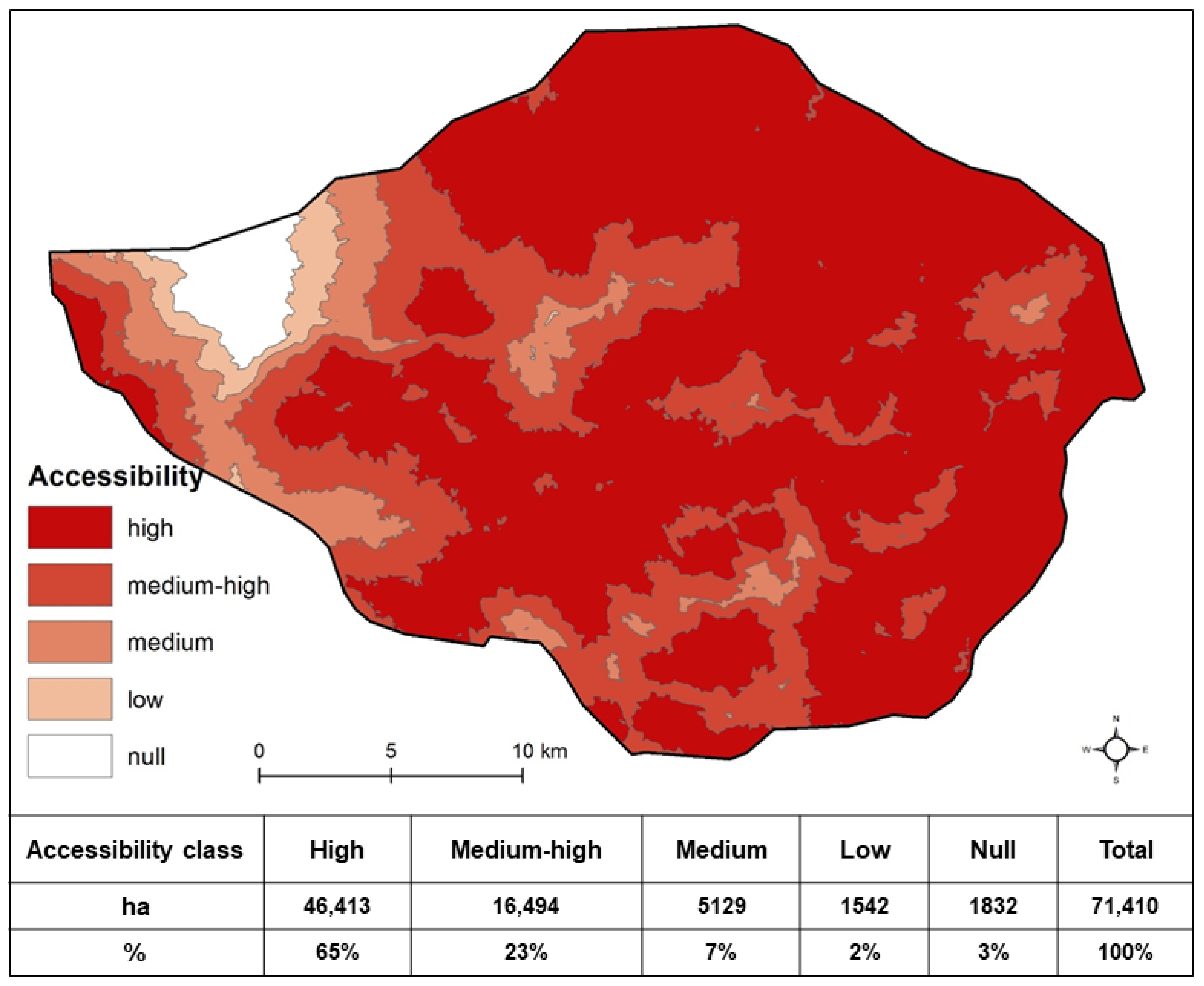
2.3.6. Mapping Land Suitability
- Accessibility Class High = 1,
- Accessibility Class Medium-high = 0.8,
- Accessibility Class Medium = 0.6,
- Accessibility Class Low = 0.4,
- Accessibility Class null = 0.2.
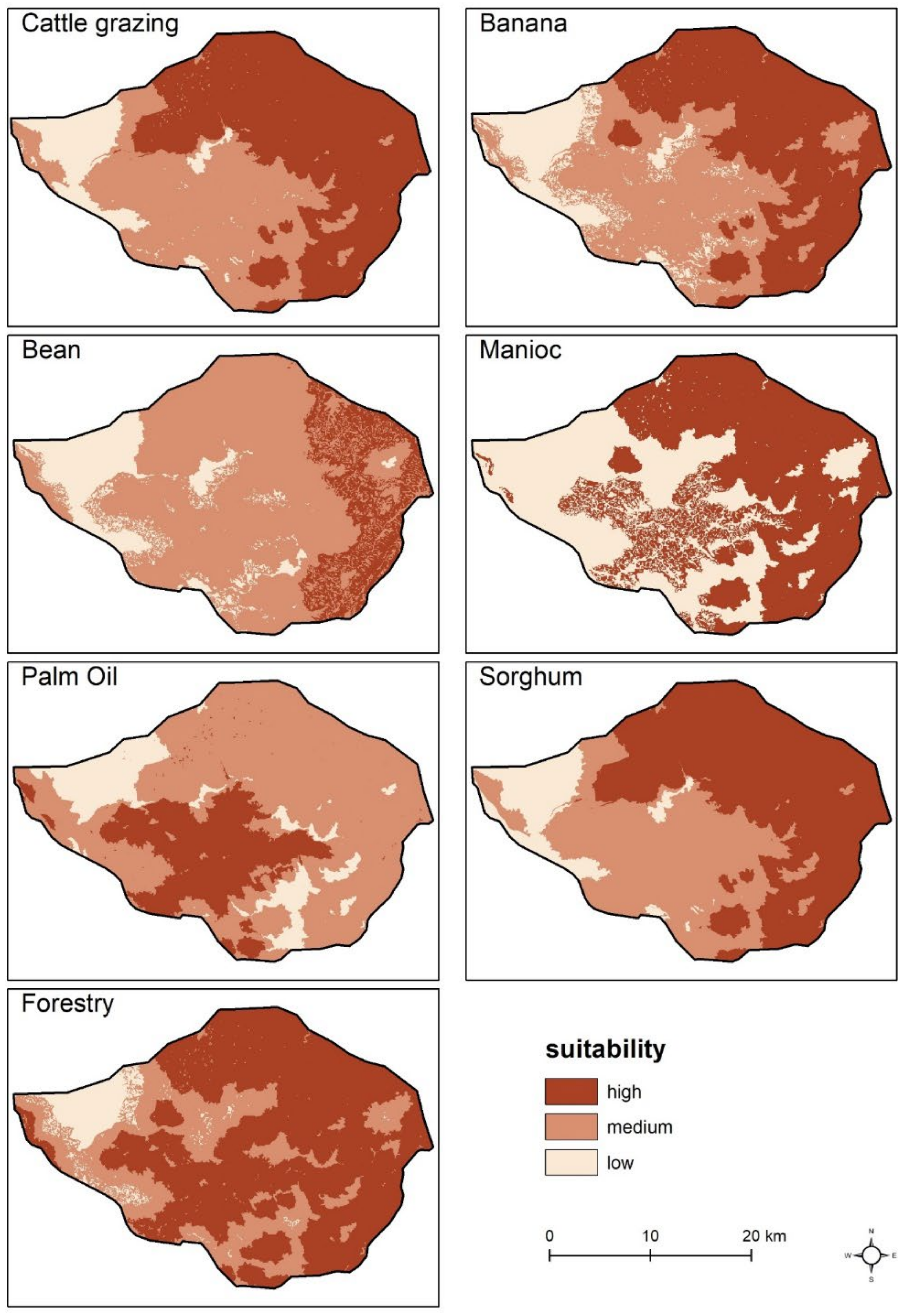
3. Results and Discussion
4. Conclusions
Author Contributions
Funding
Institutional Review Board Statement
Informed Consent Statement
Data Availability Statement
Acknowledgments
Conflicts of Interest
References
- Bagheri Bodaghabadi, M.; Martínez-Casasnovas, J.A.; Khakili, P.; Masihabadi, M.H.; Gandomkar, A. Assessment of the FAO Traditional Land Evaluation Methods, A Case Study: Iranian Land Classification Method. Soil Use Manag. 2015, 31, 384–396. [Google Scholar] [CrossRef]
- Chen, J. GIS-Based Multi-Criteria Analysis for Land Use Suitability Assessment in City of Regina. Environ. Syst. Res. 2014, 3, 13. [Google Scholar] [CrossRef]
- Senes, G.; Fumagalli, N.; Ferrario, P.S.; Rovelli, R.; Sigon, R. Definition of a Land Quality Index to Preserve the Best Territories from Future Land Take. An Application to a Study Area in Lombardy (Italy). J. Agric. Eng. 2020, 51, 43–55. [Google Scholar] [CrossRef]
- Feizizadeh, B.; Blaschke, T. Land Suitability Analysis for Tabriz County, Iran: A Multi-Criteria Evaluation Approach Using GIS. J. Environ. Plan. Manag. 2012, 2012, 1–23. [Google Scholar] [CrossRef]
- Store, R.; Kangas, J. Integrating Spatial Multi-Criteria Evaluation and Expert Knowledge for GIS-Based Habitat Suitability Modelling. Landsc. Urban Plan. 2001, 55, 79–93. [Google Scholar] [CrossRef]
- Girvetz, E.H.; Thorne, J.H.; Berry, A.M.; Jaeger, J.A.G. Integration of Landscape Fragmentation Analysis into Regional Planning: A Statewide Multi-Scale Case Study from California, USA. Landsc. Urban Plan. 2008, 86, 205–218. [Google Scholar] [CrossRef]
- Marull, J.; Pino, J.; Mallarach, J.M.; Cordobilla, M.J. A Land Suitability Index for Strategic Environmental Assessment in Metropolitan Areas. Landsc. Urban Plan. 2007, 81, 200–212. [Google Scholar] [CrossRef]
- Rojas, C.; Pino, J.; Jaque, E. Strategic Environmental Assessment in Latin America: A Methodological Proposal for Urban Planning in the Metropolitan Area of Concepción (Chile). Land Use Policy 2013, 30, 519–527. [Google Scholar] [CrossRef]
- Senes, G.; Ferrario, P.S.; Cirone, G.; Fumagalli, N.; Frattini, P.; Sacchi, G.; Valè, G. Nature-Based Solutions for Storm Water Management—Creation of a Green Infrastructure Suitability Map as a Tool for Land-Use Planning at the Municipal Level in the Province of Monza-Brianza (Italy). Sustainability 2021, 13, 6124. [Google Scholar] [CrossRef]
- FAO Land and Water Development Division. A Framework for Land Evaluation. In FAO Soils Bulletin; FAO Publishing and Multimedia Service: Rome, Italy, 1976; Volume 32. [Google Scholar]
- FAO Land and Water Division. Guidelines: Land Evaluation for Extensive Grazing. In FAO Soils Bulletin; FAO Publishing and Multimedia Service: Rome, Italy, 1991; Volume 58. [Google Scholar]
- Al-Mashreki, M.H.; Akhir, J.B.M.; Rahim, S.A.; Desa, K.; Lihan, T.; Haider, A.R. Land Suitability Evaluation For Sorghum Crop in the Ibb Governorate, Republic of Yemen Using Remote Sensing And GIS Techniques. Aust. J. Basic Appl. Sci. 2011, 10, 359–368. [Google Scholar]
- Ashraf, S.; Normohammadan, B. Qualitative Evaluation of Land Suitability for Wheat in Northeast-Iran Using FAO Methods. Indian J. Sci. Technol. 2011, 4, 703–707. [Google Scholar] [CrossRef]
- Bhattarai, K.; Yousef, M.; Greife, A.; Naraharisetti, S. Influence of Topography on Sustainable Land Management: An Analysis of Socioeconomic and Ecodemographic Conditions of Nepal. Agriculture 2020, 10, 224. [Google Scholar] [CrossRef]
- Li, Y.; Yang, X.; Long, W. Topographic Dependence of Cropland Transformation in China during the First Decade of the 21st Century. Sci. World J. 2013, 2013, 1–12. [Google Scholar] [CrossRef] [PubMed]
- UNSDG. United Nations Sustainable Development Cooperation Framework; UNSDG: New York, NY, USA, 2019. [Google Scholar]
- Ziadat, F.; Bruggeman, A.; Oweis, T.; Haddad, N.; Mazahreh, S.; Sartawi, W.; Syuof, M. A Participatory GIS Approach for Assessing Land Suitability for Rainwater Harvesting in an Arid Rangeland Environment. Arid. Land Res. Manag. 2012, 26, 297–311. [Google Scholar] [CrossRef]
- Zabihi, H.; Alizadeh, M.; Langat, P.; Karami, M.; Shahabi, H.; Ahmad, A.; Said, M.; Lee, S. GIS Multi-Criteria Analysis by Ordered Weighted Averaging (OWA): Toward an Integrated Citrus Management Strategy. Sustainability 2019, 11, 1009. [Google Scholar] [CrossRef]
- Vasu, D.; Srivastava, R.; Patil, N.; Tiwary, P.; Chandran, P.; Singh, S. A Comparative Assessment of Land Suitability Evaluation Methods for Agricultural Land Use Planning at Village Level. Land Use Policy 2018, 79, 146–163. [Google Scholar] [CrossRef]
- Sicat, R.; Carranza, E.; Nidumolu, U. Fuzzy Modeling of Farmers’ Knowledge for Land Suitability Classification. Agric. Syst. 2005, 83, 49–75. [Google Scholar] [CrossRef]
- Bojorquez-Tapia, L.; Diaz-Mondragon, S.; Ezcurra, E. GIS-Based Approach for Participatory Decision Making and Land Suitability Assessment. Int. J. Geogr. Inf. Sci. 2001, 15, 129–151. [Google Scholar] [CrossRef]
- Dunnett, A.; Shirsath, P.B.; Aggarwal, P.K.; Thornton, P.; Joshi, P.K.; Pal, B.D.; Khatri-Chhetri, A.; Ghosh, J. Multi-Objective Land Use Allocation Modelling for Prioritizing Climate-Smart Agricultural Interventions. Ecol. Model. 2018, 381, 23–35. [Google Scholar] [CrossRef]
- Kwaku Kyem, P.A. Of Intractable Conflicts and Participatory GIS Applications: The Search for Consensus amidst Competing Claims and Institutional Demands. Ann. Assoc. Am. Geogr. 2004, 94, 37–57. [Google Scholar] [CrossRef]
- Marschall, P. Evidence-Oriented Approaches in Development Cooperation? Experiences, Potential and Key Issues; Discussion Paper/German Development Institute; Deutsches Institut für Entwicklungspolitik gGmbH: Bonn, Germany, 2018. [Google Scholar]
- European Commission. Joint Communication to the Council: A Strategic Framework for the Great Lakes region. In High Representative of the European Union for Foreign Affairs and Security Policy; European Commission: Brussels, Belgium, 2013. [Google Scholar]
- UNDP. Building Peace and Advancing Development in the Great Lakes Region; UNDP Publishing: New York, NY, USA, 2013. [Google Scholar]
- Mayne, J. Building an Evaluative Culture for Effective Evaluation and Results Management; ILAC Worki.; Institutional Learning and Change Initiative: Rome, Italy, 2008. [Google Scholar]
- IPES-Food. From Uniformity to Diversity: A Paradigm Shift from Industrial Agriculture to Diversified Agroecological Systems; International Panel of Experts on Sustainable Food systems: Brussels, Belgium, 2016. [Google Scholar]
- Barbier, J.-C.; Hawkins, P. Evaluation Cultures, Sense-Making in Complex Times; Routledge: London, UK, 2012. [Google Scholar]
- Chambers, R. Participatory Rural Appraisal (PRA)-Challenges, Potentials and Paradigm. World Dev. 1994, 22, 1437–1454. [Google Scholar] [CrossRef]
- MONUSCO. UN Reports Hundreds of Human Rights Violations as Security Situation in North Kivu Deteriorates. Available online: https://www.ohchr.org/en/press-releases/2018/12/drc-un-reports-hundreds-human-rights-violations-security-situation-north (accessed on 15 December 2018).
- Tegera, A. La Conference de Goma et La Question de La Presence Des FDLR Au Nord et Sud Kiu: Etat Des Lieux; Pole Institute: Goma, Congo, 2008. [Google Scholar]
- Gabriel Habimana. Goma; Caritas Development Goma: Goma, Congo, 2015; (Unpublished Project Document). [Google Scholar]
- Nthengwe, D. Some 17,000 People Return Home in District of Conflict-Ravaged North Kivu. Available online: https://www.unhcr.org/news/latest/2009/5/4a0add026/17000-people-return-home-district-conflict-ravaged-north-kivu.html#:~:text=Some%2017%2C000%20displaced%20Congolese%20people,agreed%20on%20peace%20in%20March (accessed on 15 December 2018).
- World Bank. World Bank Staff Estimates Based on Age/Sex Distributions of United Nations Population Division’s World Population Prospects: 2019 Revision. Available online: https://data.worldbank.org/indicator/SP.POP.1564.TO.ZS (accessed on 15 December 2020).
- Ministère Provincial du Plan of DRC MINPLAN. Localisation Des Objectifs de Développement Durable Dans Le Nord-Kivu. 2017. Available online: https://www.local2030.org/library/406/locating-the-sdgs-in-north-kivu-provincial-report.pdf (accessed on 12 November 2020).
- Mahrt, K.; Nanivazo, M. Growth and Poverty in the Democratic Republic of Congo. In Growth and Poverty in Sub-Saharan Africa; Arndt, C., McKay, A., Tarp, F., Eds.; Oxford University Press: Oxford, UK, 2016; pp. 421–446. [Google Scholar]
- De Marinis, P.; De Petris, S.; Sarvia, F.; Manfron, G.; Momo, E.J.; Orusa, T.; Corvino, G.; Sali, G.; Borgogno, E.M. Supporting Pro-Poor Reforms of Agricultural Systems in Eastern DRC (Africa) with Remotely Sensed Data: A Possible Contribution of Spatial Entropy to Interpret Land Management Practices. Land 2021, 10, 1368. [Google Scholar] [CrossRef]
- Vlassenroot, K. Households Land Use Strategies in a Protracted Crisis Context: Land Tenure, Conflict, and Food Security in Eastern DRC; FAO: Rome, Italy, 2006. [Google Scholar]
- Sebastian, K. Agro-Ecological Zones of Africa 2009. Available online: https://www.ifpri.org/publication/agro-ecological-zones-africa. (accessed on 15 December 2020).
- CTA. Building the Evidence Base on the Agricultural Nutrition Nexus: Democratic Republic of Congo; CTA Working Papers; Université Evangélique en Afrique: Apia, Samao, 2017; Volume 17, ISBN 978-982-9003-88-1. [Google Scholar]
- Buck, C.E.; Daneshkhah, A. Uncertain Judgements: Eliciting Experts’ Probabilities. Statistics in Practice; Wiley: Hoboken, NJ, USA, 2006. [Google Scholar]
- Fischer, A.R.H.; Wentholt, M.T.A.; Rowe, G.; Frewer, L.J. Expert Involvement in Policy Development: A Systematic Review of Current Practice. Sci. Public Policy 2014, 41, 332–343. [Google Scholar] [CrossRef]
- Malczewski, J. GIS-Based Land-Use Suitability Analysis: A Critical Overview. Prog. Plan. 2004, 62, 3–65. [Google Scholar] [CrossRef]
- De Marinis, P.; Sali, G. Rapport Conclusif de l’étude Des Potentialités Agricoles En Diocèse de Goma. Projet ARDST; Caritas Development Goma: Goma, Congo, 2019. [Google Scholar]
- Akıncı, H.; Özalp, A.Y.; Turgut, B. Agricultural Land Use Suitability Analysis Using GIS and AHP Technique. Comput. Electron. Agric. 2013, 97, 71–82. [Google Scholar] [CrossRef]
- El Baroudy, A.A. Mapping and Evaluating Land Suitability Using a GIS-Based Model. Catena 2016, 140, 96–104. [Google Scholar] [CrossRef]
- Parry, J.A.; Ganaie, S.A.; Sultan Bhat, M. GIS Based Land Suitability Analysis Using AHP Model for Urban Services Planning in Srinagar and Jammu Urban Centers of J&K, India. J. Urban Manag. 2018, 7, 46–56. [Google Scholar] [CrossRef]
- Yohannes, H.; Soromessa, T. Integration of Remote Sensing, GIS and MCDM for Land Capability Classification in Andit Tid Watershed, Ethiopia. J. Indian Soc. Remote Sens. 2019, 47, 763–775. [Google Scholar] [CrossRef]
- FAO. Guidelines for Land-Use Planning; FAO Development Series 1; FAO Publishing and Multimedia Service: Rome, Italy, 1996. [Google Scholar]
- FAO. Directives: Evaluation Des Terres Pour l’Agriculture Pluviale; Bulletin Pédologique de la FAO: Rome, Italy, 1988; Volume 52. [Google Scholar]
- Pecrot, A.; Leonard, A. Dorsale Du Kivu; Carte de Sols et de la Vegetation du Congo Belge et du Rwanda-Burundi; Institut National pour L’étude Agronomique du Congo Belge: Brussells, Belgium, 1960. [Google Scholar]
- Verdoodt, A.; van Ranst, E. Land Evaluation for Agricultural Production in the Tropics: A Large Scale Land Suitability Classification for Rwanda; Ghent University, Laboratory of Soil Science: Ghent, Belgium, 2003. [Google Scholar]
- Verburg, P.H.; Overmars, K.P.; Witte, N. Accessibility and Land-Use Patterns at the Forest Fringe in the Northeastern Part of the Philippines. Geogr. J. 2004, 170, 238–255. [Google Scholar] [CrossRef]
- Hippoliti, G. Sulla Determinazione Delle Caratteristiche Del La Viabilità Forestale. Ital. J. For. Mt. Environ. 1976, 31, 241–255. [Google Scholar]
- Grigolato, S.; Pellegrini, M.; Cavalli, R. Temporal Analysis of the Traffic Loads on Forest Road Networks. Iforest 2013, 6, 255–261. [Google Scholar] [CrossRef]
- Laschi, A.; Neri, F.; Montorselli, N.B.; Marchi, E. A Methodological Approach Exploiting Modern Techniques for Forest Road Network Planning. Croat. J. For. Eng. 2016, 13, 319–331. [Google Scholar]
- Hossain, M.S.; Islam, M.N.; Rahman, M.M.; Mostofa, M.G.; Khan, M.A.R. Sorghum: A Prospective Crop for Climatic Vulnerability, Food and Nutritional Security. J. Agric. Food Res. 2022, 8, 100300. [Google Scholar] [CrossRef]
- De Marinis, P.; Spada, A.; Aristil, J. Evaluation Des Paramètres Productifs et Quantification d’aflatoxine de Sept Variétés de Maïs (Zea Mays L.) Testées En Haïti Yield Evaluation and Aflatoxin Quantification of Seven Maize Varieties (Zea Mays L.) Tested in Haiti. Int. J. Biol. Chem. Sci. 2019, 13, 3009–3022. [Google Scholar] [CrossRef]
- Gaye, M. Les Cultures Céréalières Dans Le Bassin Arachidier: Motivations et Contraintes; Institut National de Recherche Agricoles: Dakar, Senegal, 1994. [Google Scholar]
- Samaké, O.; Smaling, E.M.A.; Kropff, M.J.; Stomph, T.J.; Kodio, A. Effects of Cultivation Practices on Spatial Variation of Soil Fertility and Millet Yields in the Sahel of Mali. Agric. Ecosyst. Environ. 2005, 109, 335–345. [Google Scholar] [CrossRef]
- Cox, T.P. The Land as a Casualty: Soil, Cattle, and the Future in South Kivu, DRC. Ph.D. Thesis, University College Department of Anthropology, London, UK, 2008. [Google Scholar]
- Blaise, M.M. Land, Power and Identity. The Politics of Scale and Violent Conflict in Masisi, “DR Congo”. Ph.D. Thesis, University of Bayreuth: Bayreuth International Graduate School of African Studies (GIGSAS), Bayreuth, Germany, 2017. [Google Scholar]

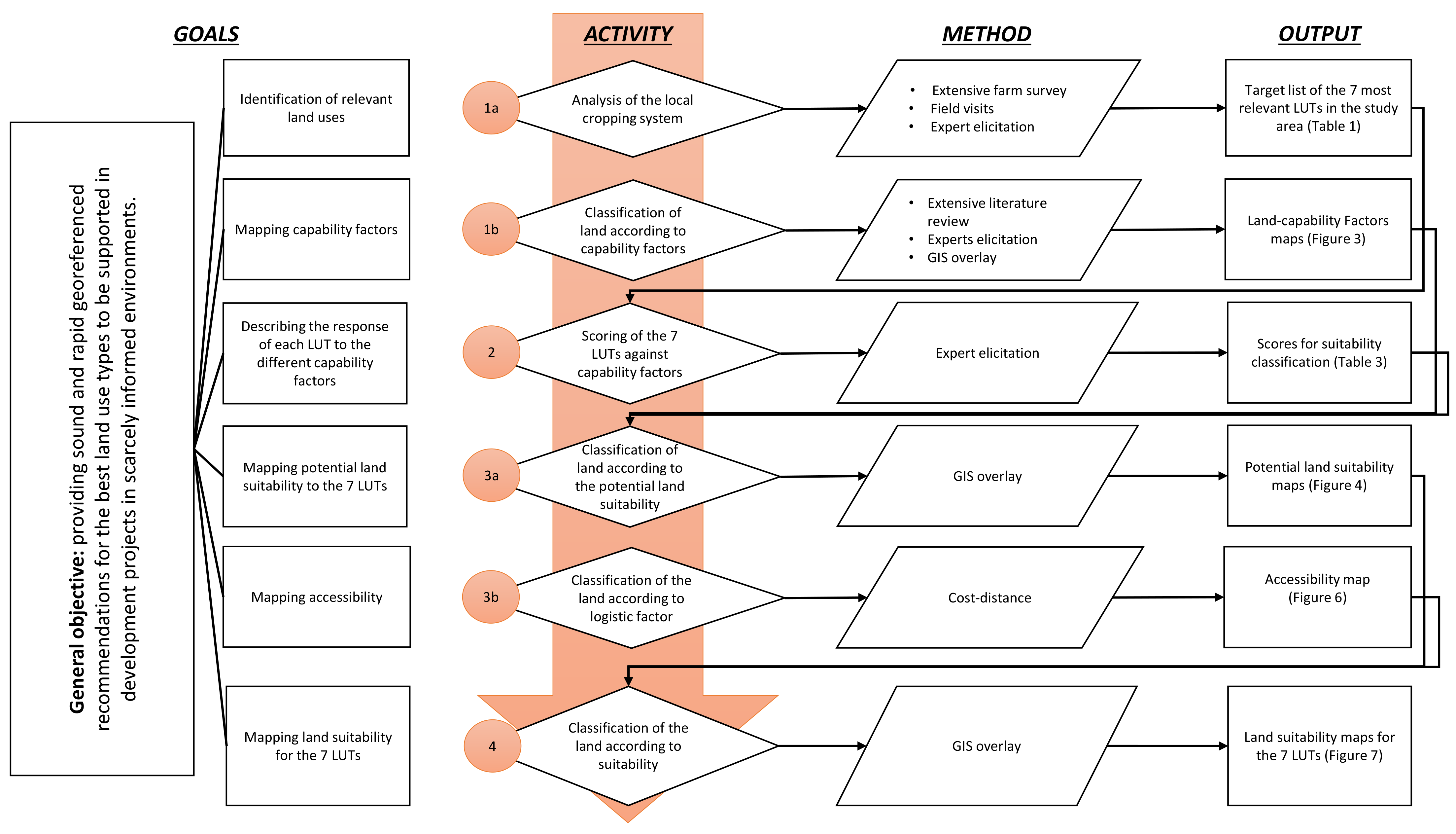
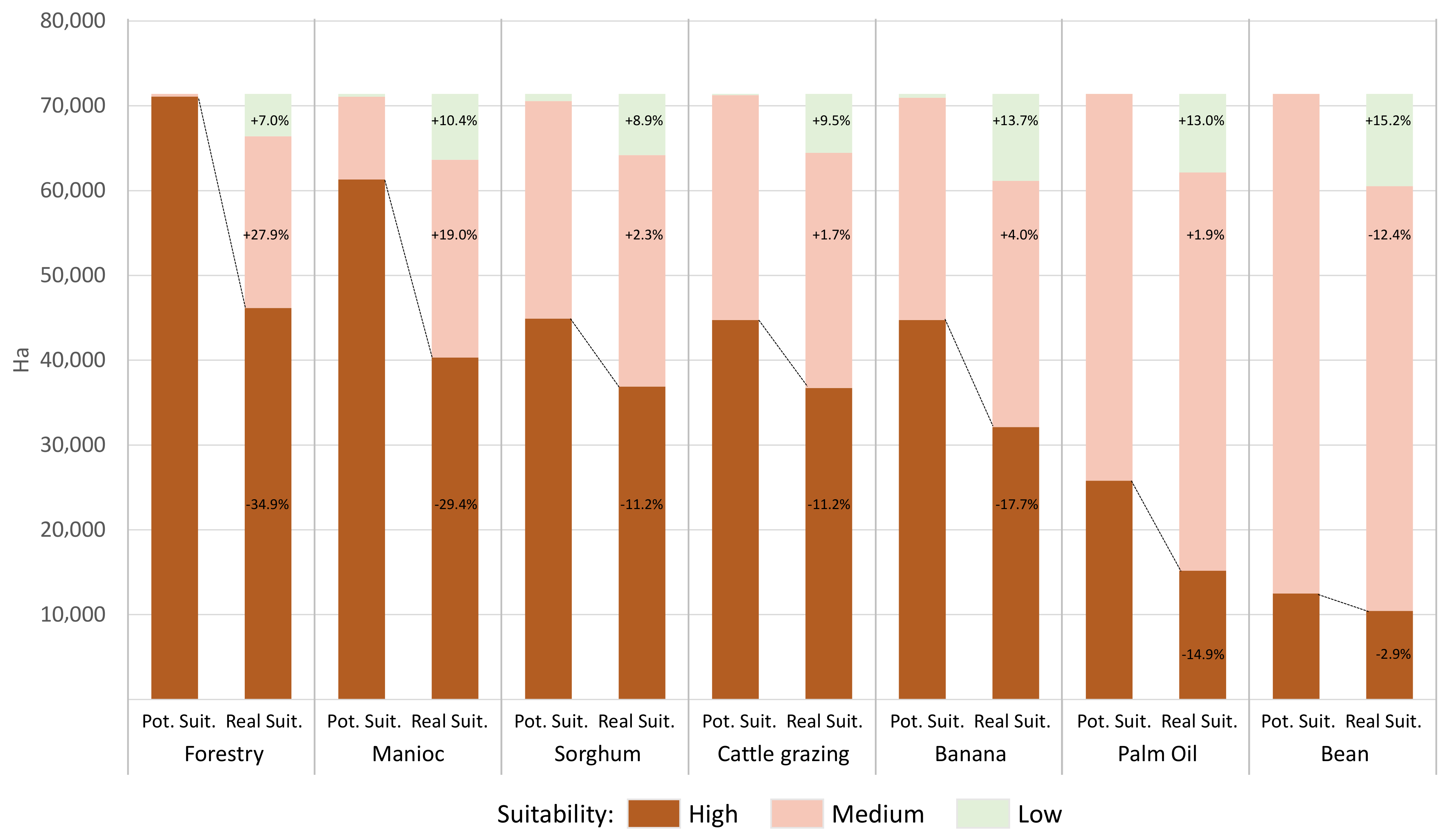
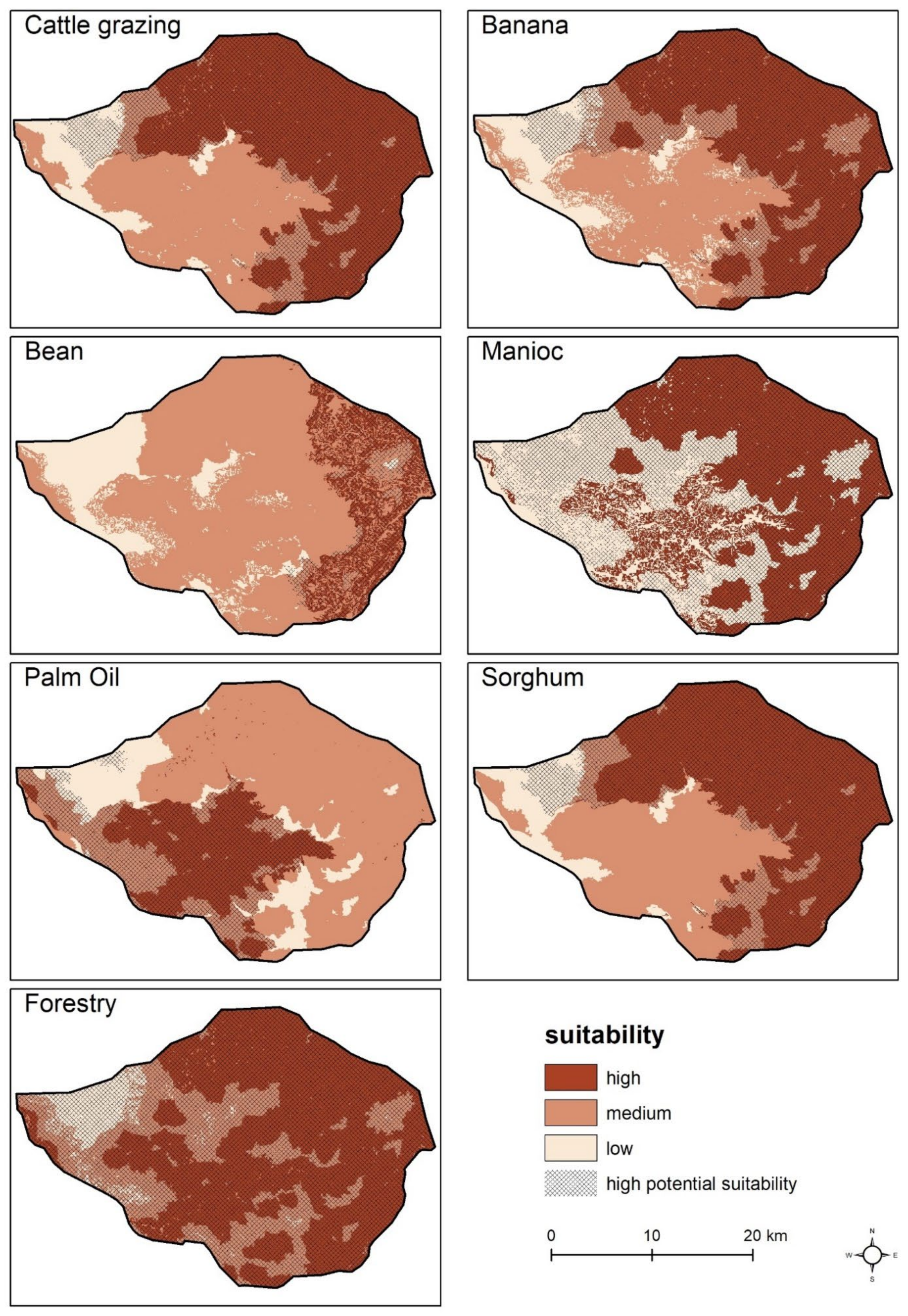
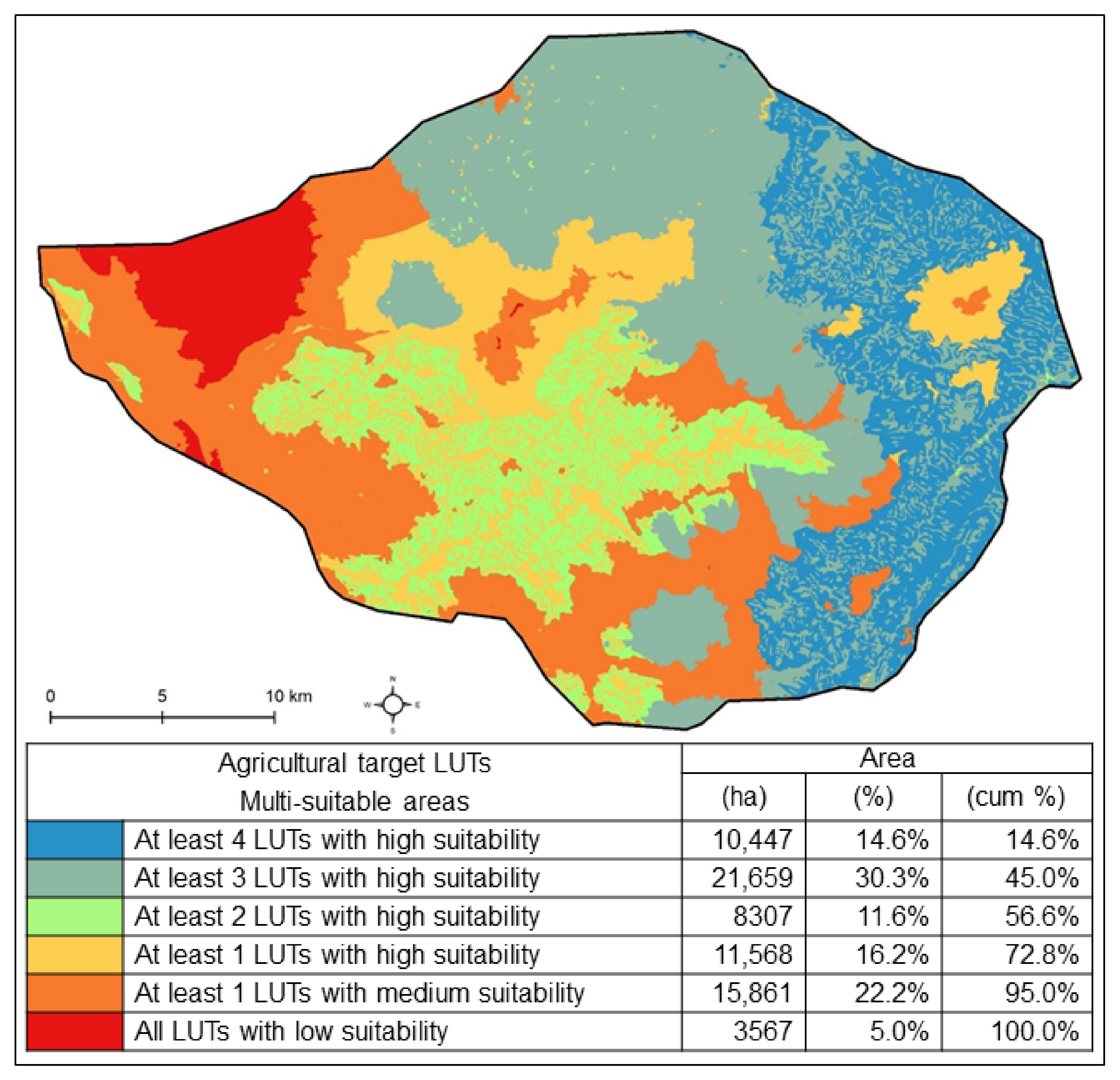
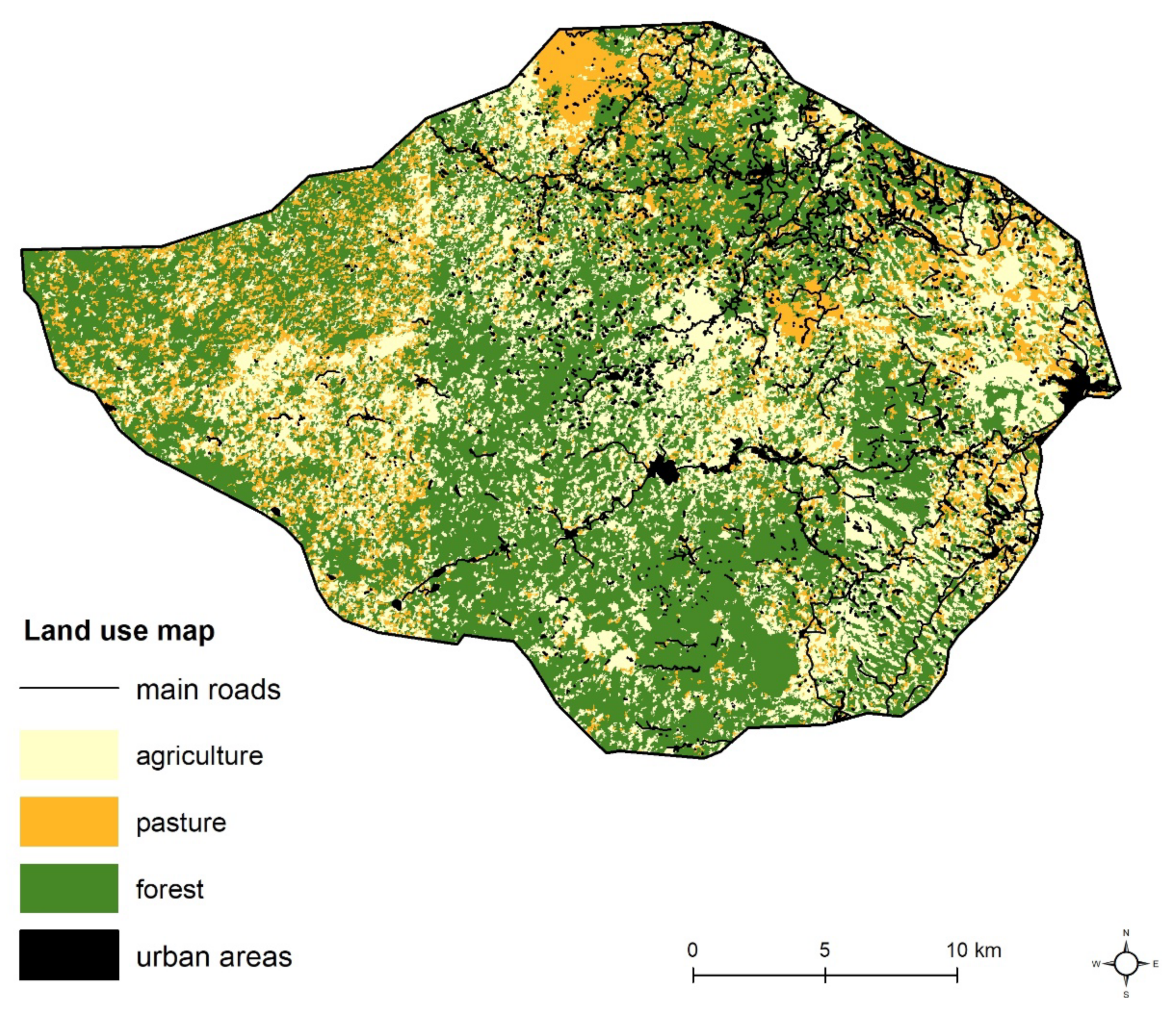
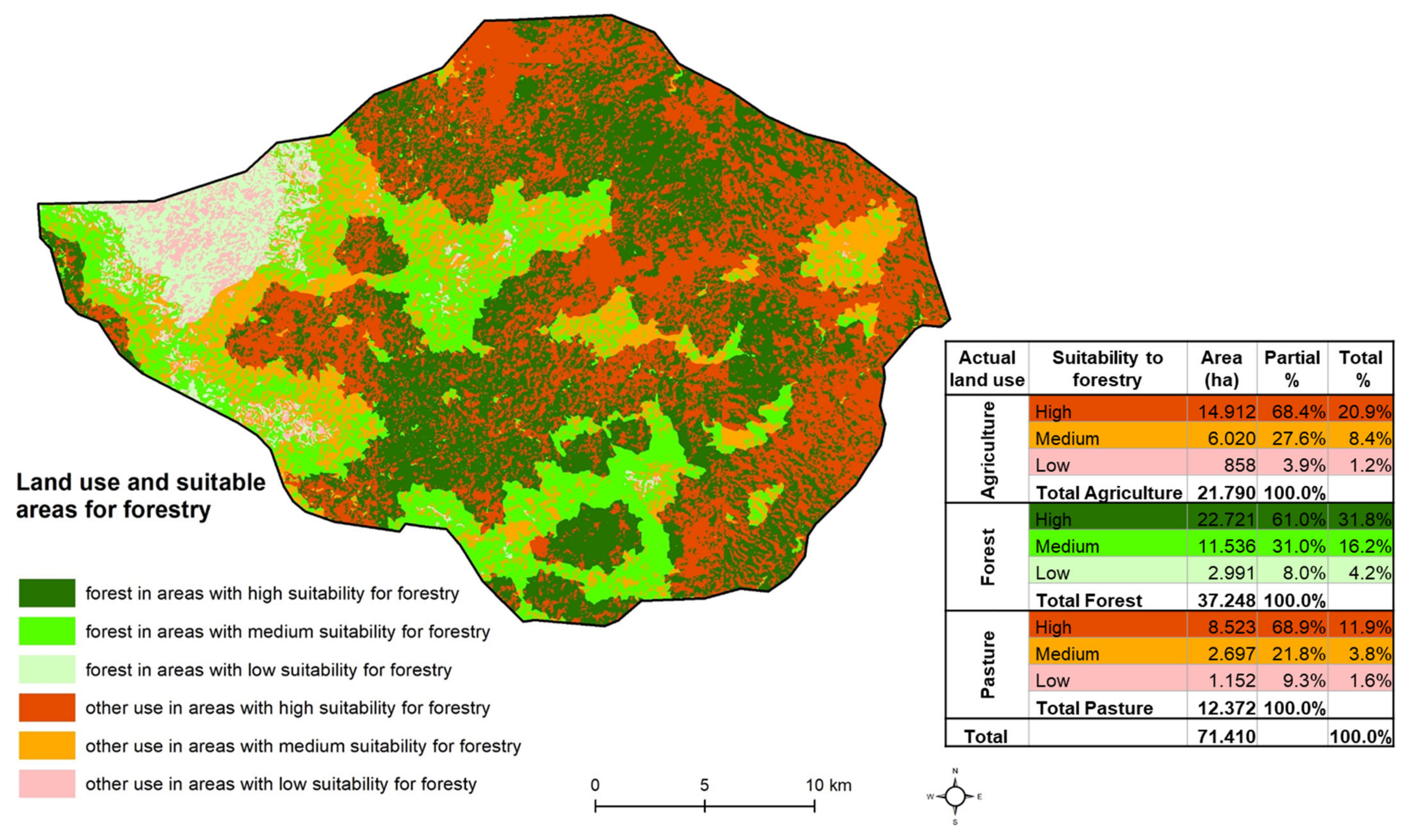
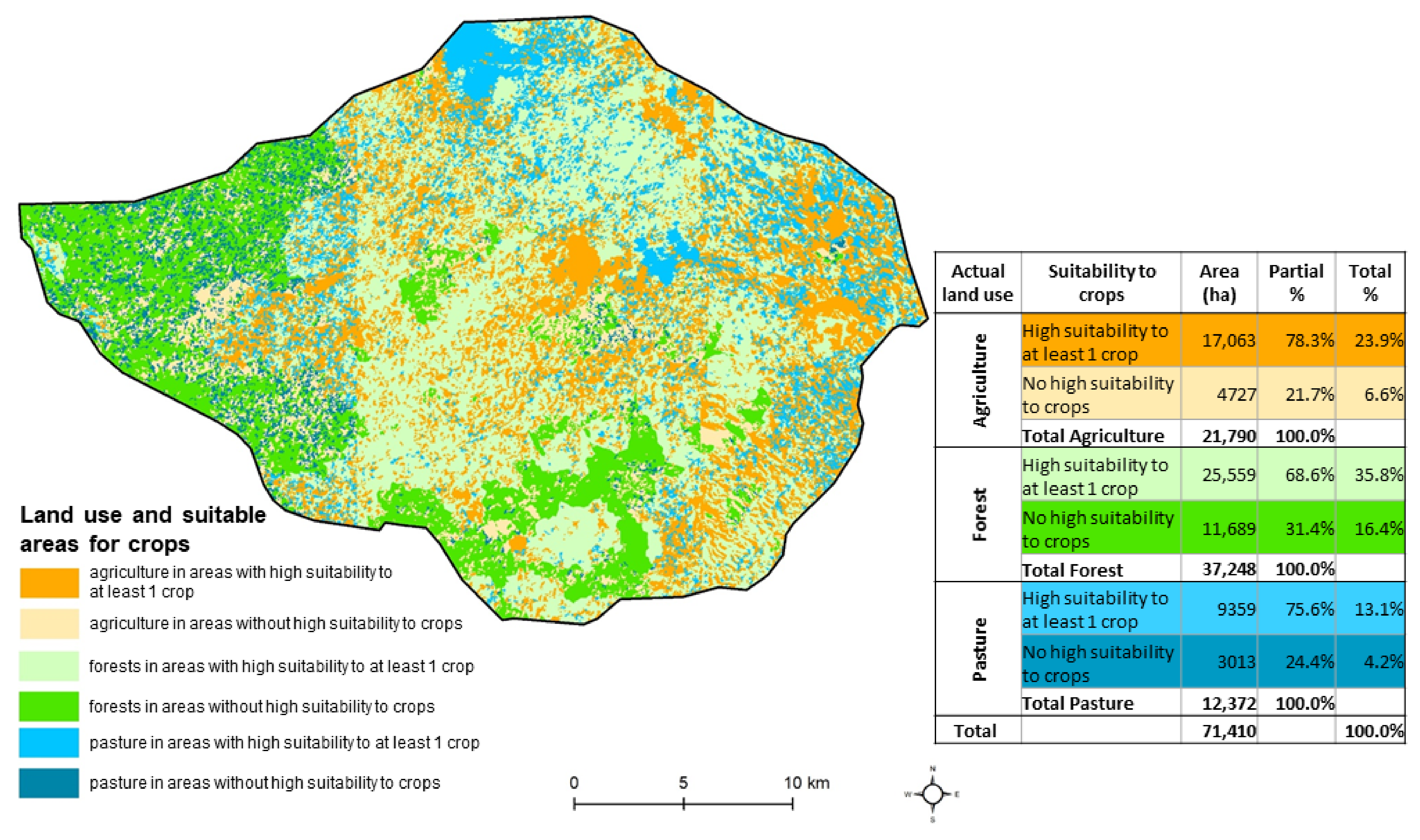
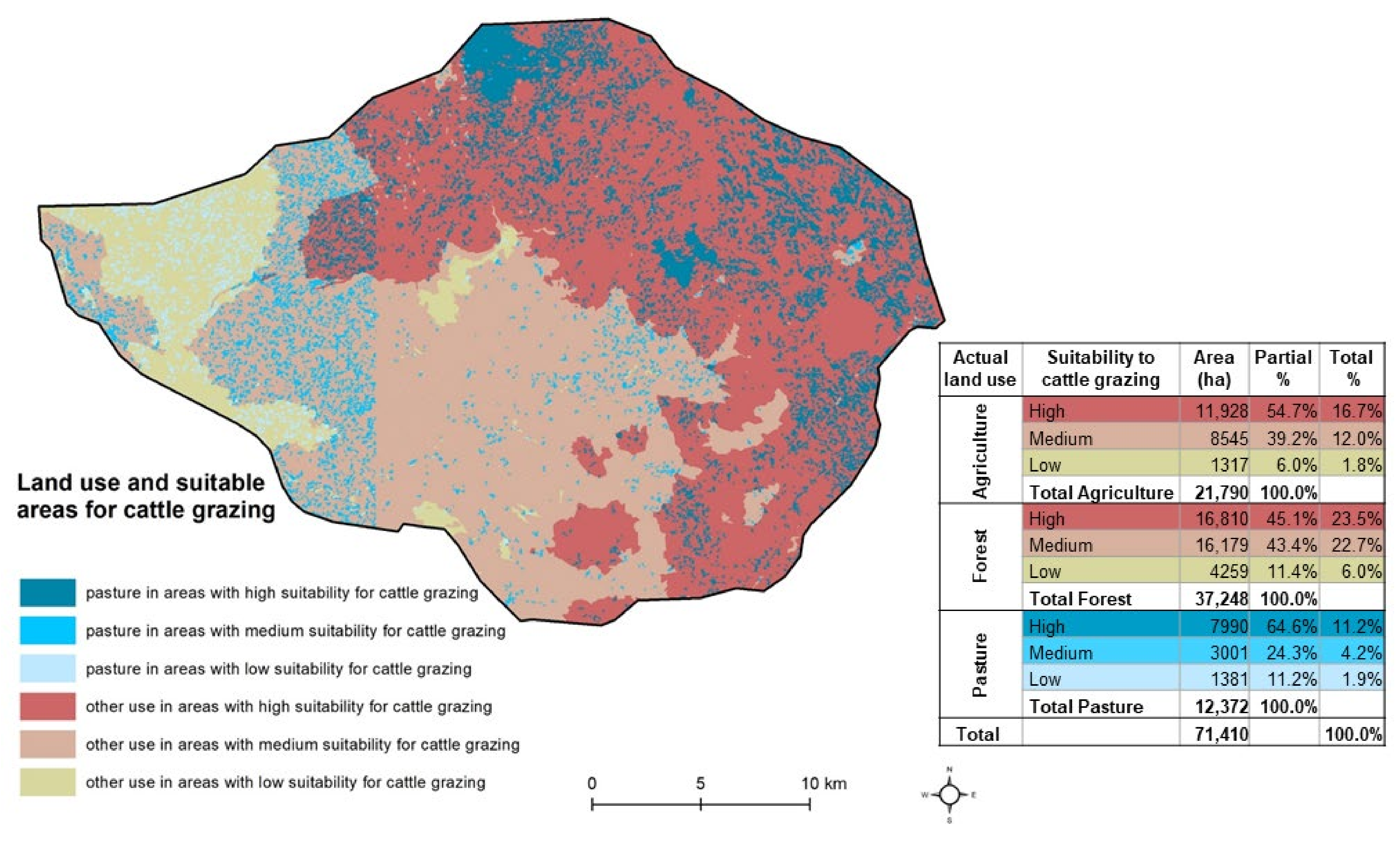
| LUT | Scientific Name |
|---|---|
| Cattle grazing | |
| Banana | Musa acuminata |
| Bean | Phaseulus vulgaris |
| Manioc | Manihot esculenta |
| Oil Palm | Elaeis guineensis |
| Sorghum | Sorgum bicolor |
| Forestry |
| LCF | Proxy | Data Source and Resolution |
|---|---|---|
| Climatic factor | Elevation classes | ASTER (Advanced Spaceborne Thermal Emission and Reflection Radiometer) GDEM (Global Digital Elevation Model) version 2. Pixel resolution: 30 × 30 m. |
| Topographic factor | Slope classes | Slope calculation on ASTER GDEM v. 2 data. Pixel resolution: 30 × 30 m. |
| Soil factor | Soil quality (fertility) classes | “Dorsale du Kivu” Soil map. Scale 1:500,000 [52] |
| LCF | LUTs | LUTs Suitability Scores (SC) | |||||||
|---|---|---|---|---|---|---|---|---|---|
| LCF Class | Cattle Grazing | Banana | Bean | Manioc | Palm Oil | Sorghum | Forestry | ||
| Soil quality (SQ) | High | 4 | 3 | 2 | 4 | 5 | 5 | 3 | |
| Medium | 3 | 3 | 2 | 4 | 4 | 4 | 3 | ||
| Low | 2 | 2 | 3 | 1 | 1 | 1 | 3 | ||
| Mean | 3.0 | 2.7 | 2.3 | 3.0 | 3.3 | 3.3 | 3.0 | ||
| St.dev. | 1.0 | 0.6 | 0.6 | 1.7 | 2.1 | 2.1 | 0.0 | ||
| Slope (SL) | High | 4 | 4 | 4 | 4 | 2 | 3 | 5 | |
| Medium | 4 | 3 | 3 | 3 | 2 | 3 | 4 | ||
| Low | 1 | 2 | 3 | 2 | 4 | 3 | 1 | ||
| Mean | 3.0 | 3.0 | 3.0 | 3.0 | 2.7 | 3.0 | 3.3 | ||
| St.dev. | 1.7 | 1.0 | 0.5 | 1.0 | 1.2 | 0.0 | 2.1 | ||
| Elevation (EL) | High | 4 | 4 | 4 | 3 | 1 | 4 | 3 | |
| Medium | 4 | 4 | 3 | 3 | 1 | 4 | 3 | ||
| Low | 1 | 1 | 2 | 2 | 5 | 1 | 3 | ||
| Mean | 3.0 | 3.0 | 2.8 | 2.7 | 2.3 | 3.0 | 3.0 | ||
| St.dev. | 1.7 | 1.7 | 0.8 | 0.6 | 2.3 | 1.7 | 0.0 | ||
| LUT | High | Medium | Low | ||||
|---|---|---|---|---|---|---|---|
| (%) | (ha) | (%) | (ha) | (%) | (ha) | ||
| Forestry | Potential suitability | 99.6% | 71,102 | 0.4% | 308 | 0.0% | 0 |
| Real suitability | 64.6% | 46,156 | 28.4% | 20,253 | 7.0% | 5001 | |
| Manioc | Potential suitability | 85.9% | 61,326 | 13.6% | 9742 | 0.5% | 342 |
| Real suitability | 56.5% | 40,327 | 32.6% | 23,312 | 10.9% | 7771 | |
| Sorghum | Potential suitability | 62.9% | 44,900 | 35.9% | 25,660 | 1.2% | 850 |
| Real suitability | 51.7% | 36,886 | 38.2% | 27,307 | 10.1% | 7217 | |
| Breeding | Potential suitability | 62.6% | 44,736 | 37.2% | 26,530 | 0.2% | 144 |
| Real suitability | 51.4% | 36,729 | 38.8% | 27,724 | 9.7% | 6957 | |
| Banana | Potential suitability | 62.6% | 44,735 | 36.7% | 26,211 | 0.6% | 464 |
| Real suitability | 45.0% | 32,107 | 40.7% | 29,046 | 14.4% | 10,257 | |
| Palm Oil | Potential suitability | 36.1% | 25,793 | 63.9% | 45,617 | 0.0% | 0 |
| Real suitability | 21.3% | 15,182 | 65.8% | 46,959 | 13.0% | 9269 | |
| Bean | Potential suitability | 17.5% | 12,496 | 82.5% | 58,914 | 0.0% | 0 |
| Real suitability | 14.6% | 10,447 | 70.1% | 50,074 | 15.2% | 10,889 | |
Publisher’s Note: MDPI stays neutral with regard to jurisdictional claims in published maps and institutional affiliations. |
© 2022 by the authors. Licensee MDPI, Basel, Switzerland. This article is an open access article distributed under the terms and conditions of the Creative Commons Attribution (CC BY) license (https://creativecommons.org/licenses/by/4.0/).
Share and Cite
De Marinis, P.; Ferrario, P.S.; Sali, G.; Senes, G. The Rapid and Participatory Assessment of Land Suitability in Development Cooperation. Sustainability 2022, 14, 13049. https://doi.org/10.3390/su142013049
De Marinis P, Ferrario PS, Sali G, Senes G. The Rapid and Participatory Assessment of Land Suitability in Development Cooperation. Sustainability. 2022; 14(20):13049. https://doi.org/10.3390/su142013049
Chicago/Turabian StyleDe Marinis, Pietro, Paolo Stefano Ferrario, Guido Sali, and Giulio Senes. 2022. "The Rapid and Participatory Assessment of Land Suitability in Development Cooperation" Sustainability 14, no. 20: 13049. https://doi.org/10.3390/su142013049
APA StyleDe Marinis, P., Ferrario, P. S., Sali, G., & Senes, G. (2022). The Rapid and Participatory Assessment of Land Suitability in Development Cooperation. Sustainability, 14(20), 13049. https://doi.org/10.3390/su142013049








